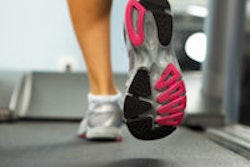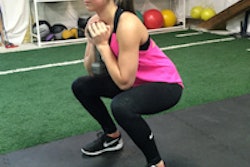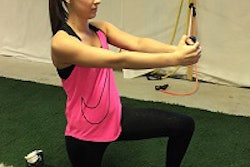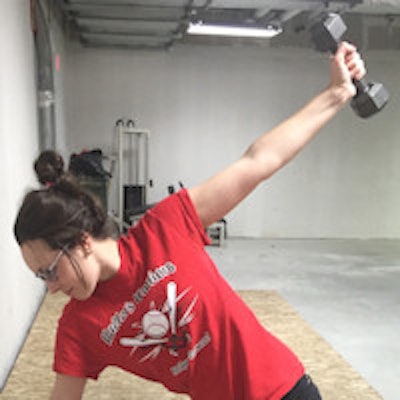
When we work with a variety of folks from across the world -- from sonographers to athletes, and from young folks to our more mature population -- we find one thing in common: One of the fastest ways to clean up nagging shoulder, neck, or lower-back problems is to improve midback mobility with targeted thoracic spine stretches and exercises.
The thoracic spine refers to the upper and middle back; it joins the cervical spine and extends down about 5 inches past the bottom of the shoulder blades, where it connects with the lumbar spine.
As we move less and less and sit more and more, the thoracic spine area takes on more load, with less ability to function correctly. When the cervical spine and the lumbar spine are both "stable" areas, our backs have mobility. However, chronic postural adaptations, faulty loading patterns, or even just bad luck can lead to mobility loss in the thoracic spine, restricting free movement and causing back pain when we try to move through the cervical and lumbar spine.
Other adaptations and lifestyle habits can also cause rounded shoulders, alter rib-cage structure, and throw off abdominal mechanics; this makes it difficult to raise your arms over your head without a compensating movement somewhere else in the body. We've all seen someone try to press something over his or her head, and because of a lack of mobility, the head is pushed forward and the lower back moves into an overarched position. This causes additional problems if not corrected.
To help get more mobility back into the thoracic spine, here are a few exercises that we know will increase movement patterns in the whole body.
Add rotation to extension drills
If you think you've done your due diligence by extending your back a few times over a foam roller during warmups, think again. Purely extension-based mobilizations don't necessarily fit with what we know about the bony architecture of this region of the spine.
Thoracic vertebrae have a unique shape, being larger in the back than in the front. This creates a natural wedge that biases the entire region toward rounding forward and acts as a bony block to standing up straight.
Two of my favorite drills are the lying thoracic spine rotation and the kneeling thoracic spine rotation, which were included in the second article of our series.
Mobilize from the inside out
We are indeed big believers in stretching and foam rolling as part of your corrective plan to get your back into shape. But it's crucial to keep breathing in mind when setting up your training program.
From a mobility and stability point of view, it's crucial to understand how breathing affects thoracic spine position and the ability to move correctly. Think of it this way: The average person takes 20,000 breaths each day and even more if performing strenuous work. If this movement pattern is off, we are doing a lot of incorrect movements during the day. As a result, we need to correct how we breathe in order to give us a fighting chance to feel right and relieve back pain.
If you're a chest breather and the diaphragm isn't doing what it should, we have a problem. The muscles in the chest and upper rib cage get stronger and built-up, causing a posture change. The shoulders get rounded and the upper body leans forward, a dynamic that limits thoracic mobility.
Here are some drills that help with breathing and thoracic mobility.
Short-seated wall reach
Sit on the floor with your back and hips against a wall. Breathe in fully through your nose before forcefully exhaling through your mouth and reaching forward with your arms. Your lower back should stay on the wall throughout the drill. Folks who have a hard time sitting on the ground can sit in a chair and then reach forward to grab their ankles.
 All images courtesy of Doug Wuebben.
All images courtesy of Doug Wuebben.Concentrate on filling the back of your chest wall with air while breathing in, and reaching your shoulder blades as far around the front of your ribs as possible on the way out. Repeat for two to three sets of three to four breaths. Pause for three seconds at the end of each breath.
Overhead breathing squat
Building on the short-seated wall reach exercise, the overhead breathing squat adds a standing component, followed by movement of the arms into an overhead position.
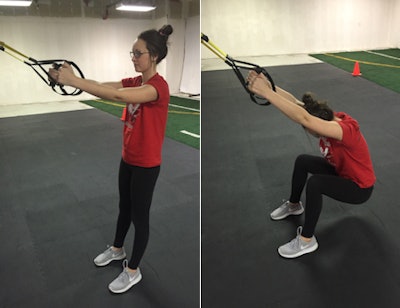
We use two straps, but you can also use stretch bands. If you don't have those available but are at a gym, you can use a lat pull-down machine with a long straight bar.
Cementing new ranges of motion
Most people intuitively appreciate the link between improved mobility and static stretching or foam rolling, but we shouldn't overlook the role that strength and stability training plays in maintaining these gains. Try pairing one of the thoracic mobility drills above with one of the following strength exercises.
Band-resisted thoracic rotations
This drill brings the abductors and external rotators of the shoulder into play. Think of working in thoracic mobility while improving shoulder range of motion. Coach's tip: Keep your hips and lower back from doing the work.
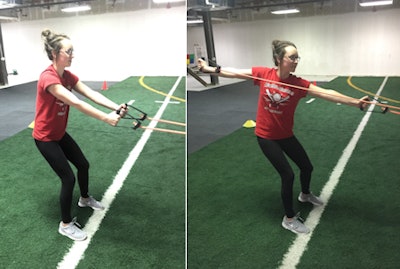
Modified reverse dumbbell fly
Like the previous drill, the modified reverse dumbbell fly adds shoulder work into the mix, but this time there's a bit more explosiveness to mimic the demands of real-world rotational force. We increase the speed of movement in this drill, but always with control.
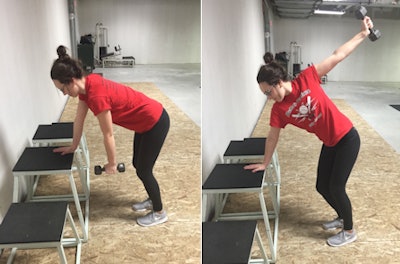
Work one or two of these movements into a routine a few times a week, and you'll notice a huge difference in how you move, how your breathing improves, and how you start to live free of back pain.
Join us later for article No. 4 in the series, in which we'll address limited hip mobility and what you can do to move right in order to feel right.
Doug Wuebben is a registered echocardiographer and also a consultant, international presenter, and author of e-books in the areas of ergonomics, exercise and pain, and injury correction for sonographers. He has also been published on the topics of telemedicine and achieving lab accreditation.
Mark Roozen is a certified strength and conditioning specialist, a certified personal trainer, and a fellow of the National Strength and Conditioning Association (NSCA). He also consults, presents, writes, and works with groups, teams, and organizations around the world. He has been in the strength, conditioning, and performance field for over 30 years.
Wuebben and Roozen are co-founders of Live Pain Free -- The Right Moves. Email [email protected] or go to coachrozy.com for more information on programs, training, or speaking requests, or if you have any questions or comments.
The comments and observations expressed do not necessarily reflect the opinions of AuntMinnie.com.





